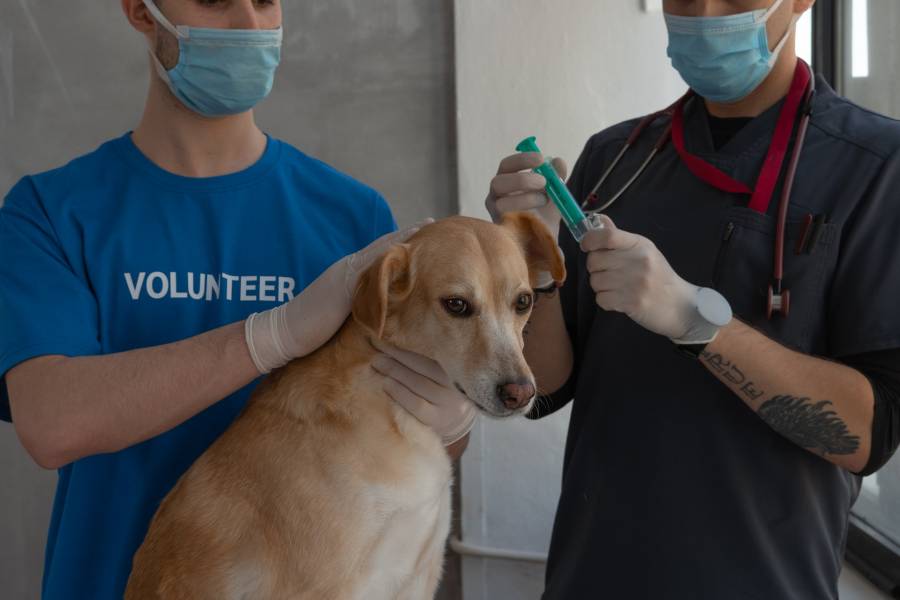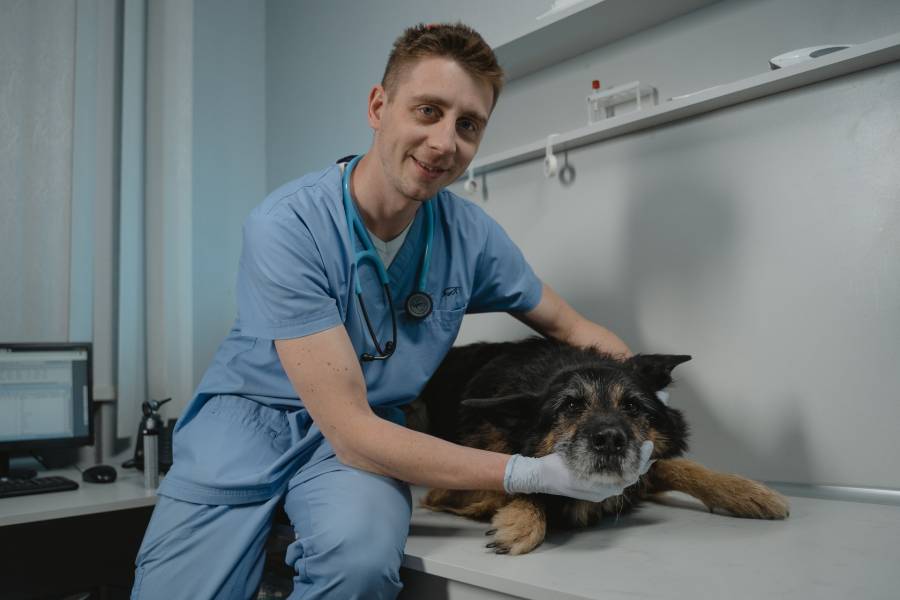Quick Navigation
If your dog undergoes a laceration repair, it’s neutered or spayed, and it will have an incision.
This incision is usually closed using staples, suture glue, or stitches.

For this particular post, we will be highlighting a dog that undergoes neutering and its stitches open with time or put dog neuter stitches open.
What Are Dog Neuter Stitches?
Dog neuter stitches are simply that, stitches. Dogs tend to get these stitches after an incision has been made during neutering or castration.
And in case you are wondering, neutering or castration is the process of removing a dog’s testicles.
Why Dog Neuter Stitches Open?
Some animals will take out their own sutures or staples after surgery before the wounds have completely healed.
There are several reasons why dog neuter stitches open.
For instance, if the surgery did not do the job correctly, chances are a dog’s neuter stitches will start to open.
Another reason why dog neuter stitches open is the dog itself. For dogs, neuter stitches tend to be itchy.
When there is too much motion or activity on the wound, the stitches or staples may pop out.
As such, they’ll do just about anything to do away with them even before they’ve healed.
It includes licking, scratching, or even chewing the stitches.
The stitches will give in at some point, especially if a dog does this for a while. In other words, the dog’s neuter stitches will open.
It is why you usually see dogs with neutering or castration surgery walking around with a cone around their neck.
This cone of shame (or collar) prevents them from interfering with their incision(s).
Additionally, stitches and staples may come out as a result of wound infection or wound dehiscence.
Is It Normal For Dog Neuter Stitches To Open?
Yes, it’s normal for dog neuter stitches to open.
That’s why you usually see dogs walking around with a cone of shame (collar) around their neck.
It, however, doesn’t mean you shouldn’t care for open dog neutering or take it lightly.
It would be best to be very concerned when dog neuter stitches open.
The opening can be an avenue for germs or bacteria to enter a dog’s body system.
In most cases, this results in a dog developing numerous health conditions, some of which can be life-threatening.
What Should I Do If My Dog Neuter Stitches Open?
If your dog’s neuter stitches open, contact your vet first thing you need to do is your dog’s neuter stitches open.
Failure to do so exposes your dog to bacteria or germs that might be dangerous health-wise for your dog.
Your vet will be in a position to do several things.
One, they’ll be able to stitch it back together. Two, your vet will give the incision proper care.
In other words, they’ll make sure it is clean before stitching it back together.
Three, they’ll give valuable advice on how to prevent your dog’s neuter stitches from opening in the future.
Before a vet gets to attend to your dog, there are a few things you need and can do to care for open dog neuter stitches.
For instance, you must clean up your dog’s neuter stitches.
Cleaning open dog neuter stitches involves keeping them dry.
Take a clean cloth or baby wipes (free of any additives) and gently wipe the open incision area.
Worth pointing out that specific dog-approved wipes are perfect for such a situation.
To determine the severity of the situation, your veterinarian will examine the wound.
Repeat surgery may be required to clean up and close the wound on your pet.
Painkillers and antibiotics might be necessary.
Preventing Your Dog From Chewing, Licking, Or Scratching Neuter Stitches
You must prevent your dog from chewing, licking, or scratching the area.
You can do this by ensuring your dog wears a cone at all times.

If you are not a big fan of the dog collar, you can factor in other things to help protect open dog neuter stitches. They are:
- Anti-Licks or sprays that a vet approves
- Distracting toys and dog puzzles
- Socks and T-shirts (if approved by a vet)
- Tranquilizers and sedations (these two, however, are and should be the last option)
In addition to these, you can and should consider crating your dog.
It works perfectly for those who are not around all day to supervise their dog after the dog’s neuter stitches open.
If you plan on using a T-shirt or socks, do remember that they are perfect if the neuter stitches are on the shoulders or abdomen.
It is essential with the T-shirt to confirm with your vet, given that some dog neuter stitches require the wound to air.
Putting on a T-shirt is likely to prevent proper aeration.
Other Notables When Talking Dog Neuter Stitches Open
There are other things worth mentioning to know whether it is normal for dog neuter stitches to open.
They include how to keep dog neuter stitches clean (whether they are open or not) and reasons why dog neuter stitches might take longer to heal.
When stitches or staples are removed or come out, different signs appear depending on where the wound is in the healing process.
The lack of staples or sutures may be the only indication of this happens late in the healing process.
On the other hand, early wound healing indicators include:
- An open wound
- Fat, organs, or bones may appear if the open wound is large enough.
- Symptoms of an infection include swelling, redness, and discharge.
- Bleeding
How To Keep Dog Neuter Stitches Clean?
Ensuring that your dog’s neuter stitches are clean is very important.
You can do it by making sure that it is dry regardless of whether it’s open or not.
Yes, a dog’s incision site should always remain dry until it completely heals.
Hence, things like bathing your dog are a no-no.
It also includes allowing your dog to play in the rain. When it’s rainy, your dog should always be inside if it has an incision.
If you are keen on keeping an incision clean, other no-nos are ointments, disinfectants, and creams.
Regardless of how logical it might seem, please don’t take any ointment, disinfectant, or cream and apply it on your dog’s incision or neuter stitches.
Other substances that you shouldn’t be tempted to apply on a dog incision are hydrogen peroxide and alcohol.
These two are even worse, given that they might damage the tissue.
Why Are My Dog’s Neuter Stitches Or Incision Not Healing?
If you suspect that your dog’s neuter stitches are not healing, you must contact a vet for much-needed advice.
However, in most cases, the dog’s neuter stitches or incisions not healing are usually down to a few causes.
For instance, maybe your dog has a pre-existing health condition like liver or kidney failure.
Hormonal imbalances can also result in an incision not healing quickly.
Medications such as aspirin, especially in high doses, are also known to prolong the healing of dog neuter stitches.
Other causes, although not as common, include a lack of Vitamin C, protein, zinc, and Vitamin A.
Conclusion
When dealing with open dog neuter stitches, it is essential to know when the right time to seek medical attention is.
That said, you should consider calling your vet if there is excessive swelling at the incision.
The same also goes for your dog’s neuter stitches incision if there is some redness.
Fresh blood seeping for more than 24 hours is another reason why you should contact a vet.
Drainage or any form of discharge from your dog’s incision is a big red flag.
It is vital to call your vet in such circumstances.
Other notables include pus, off-color drainage, or foul odor.
Protruding tissues missing sutures with some reddish swelling and (or) discharge are also why you should contact a vet.
In most cases, your dog not eating following an incision might be an indication of an issue.
Hence, a vet visit will allow you to tell what is wrong clearly.

Zoey is a long-time pet owner and animal rights advocate, a vital part of Purrfect n’ Pawesome. She shares her unique experiences and learnings with her readers to enhance their understanding of pet behavior and nutrition. Along with being an active pet writer, she volunteers at multiple animal shelters, rescue centres with some bespokenly awesome pets.
Zoey has a lot to share when raising the pets and spending life being their true friends. She has a quite pampered Persian cat and a Ragdoll, whom she loves the most. Readout her blogs to know more about being a responsible parent to your beloved pets.
“I love to be around cats and dogs; that’s my passion and my trick to get away from all the negativity and soaking in unconditional love and affection. Being attached to this platform gives me the reason to be vocal about pet love, care, and nurturing. Although I am not an expert or veterinarian by any means, I have a lot of experience and learnings to share with my fellow readers.”




